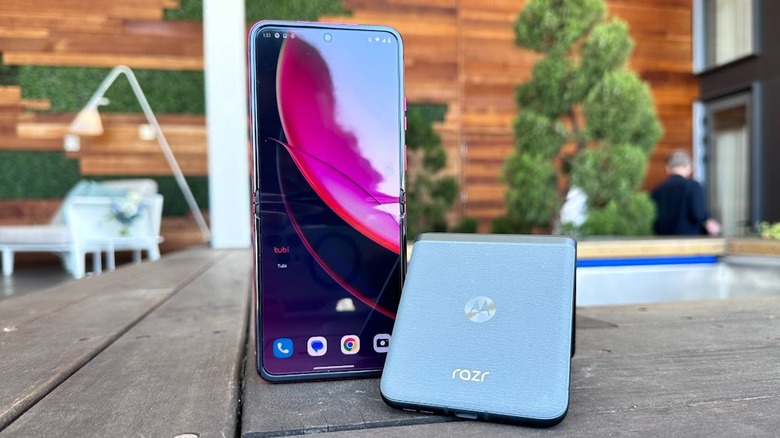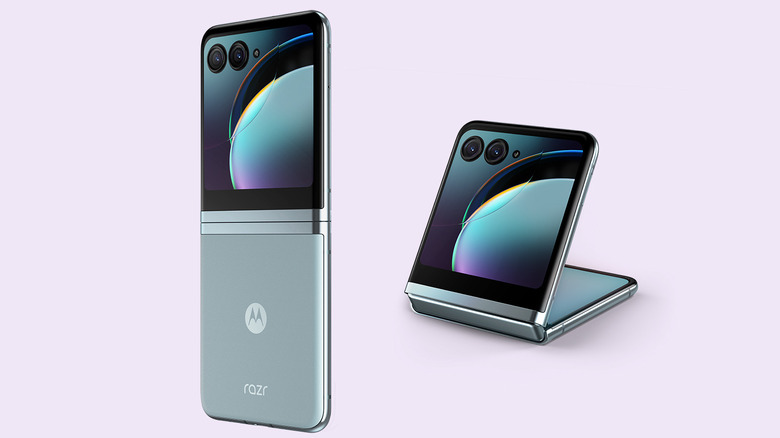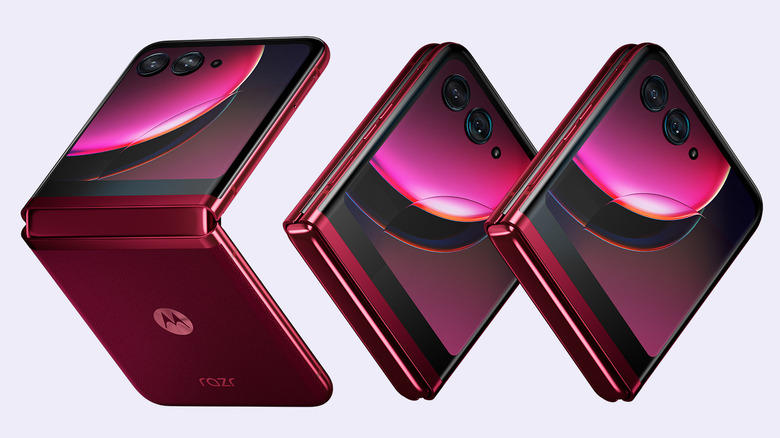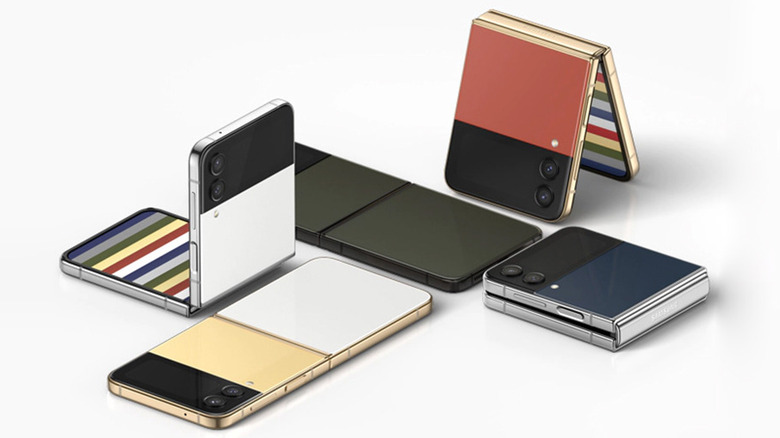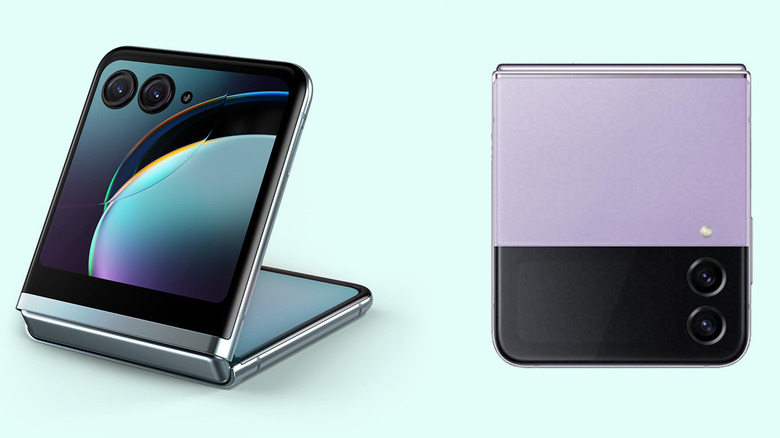Motorola Razr+ Vs. Samsung Galaxy Z Flip 4: Is The Razr The Best New Foldable?
Motorola just announced the new Razr+ 2023 clamshell smartphone with a revamped design and a much more useful outer display. Besides the improved external display, the inner display on the Razr+ has also been enhanced, while the exterior design has been reinforced with more premium materials. The new Razr+ meets the Samsung Galaxy Z Flip 4 head-on with comparable specifications.
Samsung leads the global foldables market based on data from DSCC, with the Galaxy Z Flip 4 alone accounting for nearly half of all the foldables sold in Q4 2022. The clamshell's success may be attributed to the compact form factor and ease of carrying the phone or more accessible pricing compared to the $2,000 Galaxy Fold.
While Samsung is also set to launch the Galaxy Z Flip 5 and the Fold 5 soon, the launch is still several weeks away. If you want to buy a new foldable flip phone soon, this Motorola Razr+ vs. Samsung Galaxy Z Flip 4 comparison should give you enough reasons to choose one over the other.
Display
One of the first things you notice with the Motorola Razr+ is its grand 3.6-inch outer display, which allows you to run nearly full versions of apps. The outer display on the Razr+ gets a much higher resolution of 1066 x 1056 pixels and an impressive peak brightness of 1100 nits. The refresh rate is also bumped up to 144 Hz, making it the smoothest outer display on a flip phone.
Meanwhile, the Galaxy Z Flip 4's cover display measures only 1.9 inches; it has a resolution of 260 x 512 pixels and refreshes at 60 Hz. More importantly, the Galaxy Z Flip 4's external display does not natively support apps and limits usage to predefined cards similar to a smartwatch's display, but you can work around these restrictions using third-party solutions.
The Motorola Razr+ also gets an upgrade to the inner foldable display. Measuring 6.9 inches, the display packs a 2640 x 1080 pixels resolution and a 165 Hz refresh rate, surpassing previous foldables with 120 Hz displays. Motorola also claims a peak brightness of 1400 nits for this foldable LTPO AMOLED display.
In contrast, the Galaxy Z Flip 4 gets a slightly smaller 6.7-inch display, albeit with the exact same resolution, making it a tad more pixel-dense than the Razr+. The Galaxy Z Flip 4's internal display has a 120 Hz refresh rate. While the Razr+ is arguably smoother, a 120 Hz refresh rate will not hamper your experience or make it appear less smooth unless both phones are compared side by side.
Performance and battery
Despite being launched in 2023, the Motorola Razr+ features 2022's Snapdragon 8+ Gen 1 processor, which has already been succeeded by the Snapdragon 8 Gen 2. While the last year's processor will not bring a profound difference in daily tasks, it may reduce the Razr+ 2023's prospects of getting software support a few years down the line. In contrast, the Galaxy Z Flip 4 also gets the same chipset. However, the Galaxy Z Flip 5 is expected to launch with a special souped-up version of Snapdragon 8 Gen 2 specifically designed for Galaxy smartphones. However, the extra muscle strength may come at an additional price.
Notably, both the Motorola Razr+ and the Galaxy Z Flip 4 come with 8 GB RAM. In terms of storage, you only get a 256 GB variant of the Razr+, while Samsung offers a choice among 128 GB, 256 GB, and 512 GB storage options. The Razr+ gets a 3800 mAh battery with 30 W wired charging. The Galaxy Z Flip 4 gets a marginally smaller 3700 mAh battery with slower 25 W wired charging. Both phones support wireless charging, and while the rate on the Razr+ caps at 5 W, the Galaxy Z Flip 4 can support up to 15 W wireless charging using a Samsung-branded wireless charger. Notably, the Galaxy Z Flip 4 also supports reverse wireless charging, allowing you to charge accessories such as the Galaxy Buds 2 Pro by placing them on the phone's back. Motorola does not mention similar functionality.
Cameras and design
The Motorola Razr+ gets a 12 MP optically-stable primary camera paired with an f/1.5 aperture lens and a 1.4 microns pixel size. It also gets a 13 MP ultrawide snapper with an f/2.4 aperture and a 108-degree wide field. Inside, the Razr+ also features a 32 MP camera for selfies and video calling.
The Galaxy Z Flip 4 also features a 12 MP primary shooter but with an f/1.8 aperture. Despite the smaller aperture size, the Galaxy Z Flip 4 features larger pixels measuring 1.8 microns each. In practice, this tip the scale in favor of either of the phones, depending on the software processing on each. Like the Razr+, the primary camera on the Galaxy Z Flip 4 is also optically stabilized.
Other cameras on the Galaxy Z Flip 4 include a 12 MP ultrawide angle shooter with a 123-degree wide field of view and an f/2.2 aperture. This can be expected to perform slightly better than Motorola's ultrawide camera. For selfies, Samsung offers a 10MP camera nestled inside the hole-punch cutout on the screen. In reality, the exterior cameras on both phones can capture much more crisp and detailed images by using the cover screen as the viewfinder. Both phones get glass bodies reinforced by Gorilla Glass Victus (Samsung offers the newer Victus+) and an aluminum mid-frame. Motorola also offers a vegan leather back option with its magenta color, while Samsung lets you get bespoke color options for the Galaxy Z Flip 4.
Software support and pricing
The Motorola Razr+ comes with Android 13 out of the box with a near-stock Android interface. While Motorola usually promises three years of Android version updates and four years of security updates for its flagships, no such promise has been made for the Razr+, leaving the prospects to appear bleak. On the other hand, Samsung promises four years of Android version updates and five years of security updates. Considering the Galaxy Z Flip 4 launched with Android 12 and has already received the Android 13 update, it will receive three more updates (i.e., to Android 16).
Samsung has been rolling out updates to most of its latest smartphones — not just flagships — very promptly, and the Galaxy Z Flip 4 has received Google's security patches every month. This kind of software support is reassuring for anyone looking at a long partnership with their Galaxy Z Flip 4.
In terms of pricing, the unlocked variant of Motorola Razr+ will be available for $999.99 starting June 23. Meanwhile, the Samsung Galaxy Z Flip 4 is readily available. However, for the same price of $999.99, you will get only half the storage at 128 GB. If you prefer the 256 GB model, you will have to shell out an extra $60, while the 512 GB variant warrants payment of $1,179.99.
